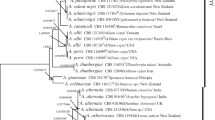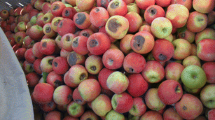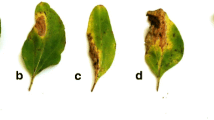A new disease of pelargonium (Pelargonium domesticum Bailey), ivy geranium (P. peltatum (L.) L'Hér. ex Ait.) and scented geranium (P. graveolens L'Hér.), primarily causing brown spots on leaves, was found in Kawasaki-shi in Kanagawa Prefecture and Tachikawa-shi in Tokyo. An Alternaria sp. was consistently isolated from these diseased leaves, and the isolates were pathogenic to their host leaves. Based on morphological characteristics, the causal fungus in all three cases was identified as Alternaria alternata (Fr.) Keissler. Because Alternaria leaf spot of geranium by A. alternata has already been reported, the pathogenicity of isolates from four groups of genus Pelargonium was investigated. The isolates from scented geranium were pathogenic only to their original host, but the isolates from pelargonium, ivy geranium and geranium were pathogenic to all groups of pelargonium. This is the first report of this disease on pelargonium, ivy geranium and scented geranium caused by A. alternata in Japan. We propose the names for these diseases as Alternaria leaf spot of pelargonium (kappan-byo), Alternaria leaf spot of ivy geranium (kappan-byo) and Alternaria leaf spot of scented geranium (kappan-byo).
Similar content being viewed by others
Author information
Authors and Affiliations
Additional information
Received 11 December 2000/ Accepted in revised form 19 July 2001
Rights and permissions
About this article
Cite this article
FURUKAWA, T., KISHI, K. Alternaria Leaf Spot on Three Species of Pelargonium Caused by Alternaria alternata in Japan. J Gen Plant Pathol 67, 268–272 (2001). https://doi.org/10.1007/PL00013028
Issue Date:
DOI: https://doi.org/10.1007/PL00013028




